Accepted Scientific Name: Larryleachia marlothii (N.E.Br.) Plowes
Excelsa 17: 7 1996
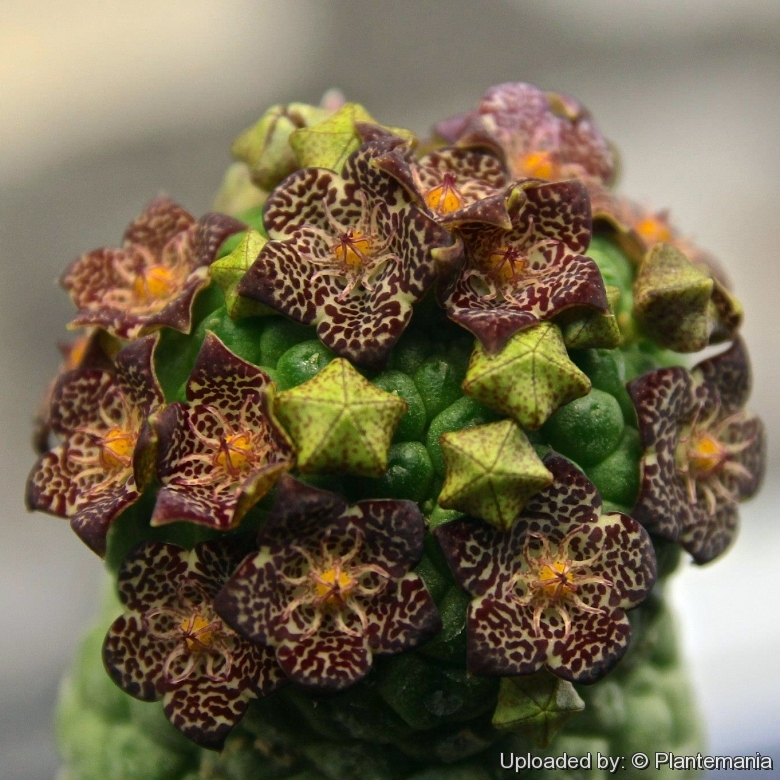
Leachiella marlothii (Larryleachia marlothii) Photo by: © Plantemania
Origin and Habitat: Larryleachia marlothiiSN|32234]]SN|32234]] is a summer-flowering succulent plant widespread throughout to South Africa (Northern Cape), Namibia and southern Angola.
Synonyms:
See all synonyms of Larryleachia marlothii
back
Accepted name in llifle Database:Larryleachia marlothii (N.E.Br.) PlowesExcelsa 17: 7 1996Synonymy: 11
back
Common Names include:
ENGLISH: Ghaap,
Description: Larryleachia marlothiiSN|32234]]SN|32234]], formerly knows as Trichocaulon marlothiiSN|32235]]SN|32235]], is a small perennial stem succulent, with 3 to 30 stems clustered from the base up to 15 cm long, hairless, grey-green, and sometimes brown, densely covered in low tubercles in 12-19 rows with depressed tips enclosing the small conical leaves. Flowers appear in the summer and feature a dark, spotted, 5-pointed corolla and a distinct cross shape in the centre. The hairless corolla-lobes and the inner corona with a conspicuous dorsal projection united with the outer corona-horns are distinctive to this species.
Derivation of specific name: This species was named after after the original collector of the species, D. R. Marloth.
Stem. 7-15 cm high, with 3–4 cylindric or cylindric-ovoid branches 20-63 mm thick, narrowed below, obtuse, 12-to 19-ribbed with crowded obtuse mammillae 4-6 mm in diameter, tipped with a minute conical leaf less than 1 mm long, seated in a small depression, glabrous, pale greyish and sometimes brown.
Flowers: 1–5 together, predominantly apical between the tubercles, subsessile or with pedicels up to 1 mm long, developing successively. Sepals 1.5-2 mm long, 1 mm broad, broadly ovate, acute, glabrous. Corolla hairless, campanulate, flat-topped and very shortly pointed in bud, when expanded about 8-16 mm in diameter, lobed to half-way down, without a distinct tube, the united part (central depression) 1-3 mm deep, flattish or saucer-shaped, margins not or only slightly thickened. Outside reddish spotted with green, glabrous and smooth, inside cream-coloured, irregularly speckled with red or dark maroon, occasionally uniformly dark purple, not ciliate. Lobes spreading, 2-5 mm long and 5 mm broad, nearly like an equilateral triangle in outline, acute, dark purple-brown tips curved outwards, margins more weakly curved. Corona cream-coloured, irregularly marked with pinkish or chestnut-brown, 3.5-4.5 mm in diameter, often with nectar droplets. Outer corona-lobes 2-5 x 3-5 mm divided into 10 filiform-subulate teeth 1-2 mm long, arranged in pairs behind the inner corona-lobes, very spreading to recurved at the tips towards each other, broadly ovate, acuminate. Inner corona-lobes 1-1.5 mm long, linear, obtuse, closely incumbent on the backs of the anthers and produced beyond them, with the tips connivent-erect.
Fruits: Follicles (mericarps) usually paired, 5-9.5 cm long, diverging at an angle of 30 -60°.
Bibliography: Major references and further lectures
1) Zdenek Jezek and Libor Kunte “The Complete Encyclopedia of Succulents: Informative Text with Hundreds of Photographs” 22 Dec 2009
2) Wikipedia contributors. "Larryleachia marlothii." Wikipedia, The Free Encyclopedia. Wikipedia, The Free Encyclopedia, 20 Jan. 2013. Web. 7 Jan. 2016.
3) Focke Albers, Ulrich Meve “Illustrated Handbook of Succulent Plants: Asclepiadaceae”, Volume 4 Springer Science & Business Media, 2002
4) N. E. Bown. “Flora Capensis”, Vol 4, 1909
5) Victor, J.E. 2005. "Larryleachia marlothii (N.E.Br.) Plowes." National Assessment: Red List of South African Plants version 2015.1. Accessed on 2016/01/07
6) James Cullen, Sabina G. Knees, H. Suzanne Cubey “The European Garden Flora Flowering Plants: A Manual for the Identification of Plants Cultivated in Europe, Both Out-of-Doors and Under Glass” Cambridge University Press, 11 August 2011
7) Bruyns. P.. “A revision of Hoodia and Lavrania.” Botanische Jahrldicher 115(2): 145-270, 1993
8) Bruyns. P., “Stapeliads of southern Africa and Madagascar” 2005.
9) White & Sloane. “The Stapelieae”, edn 2, 3: f. 1101, 1107, 1109, 1111, 1937
10) Luckhoff, “The Stapelieae of southern Africa”. 254. 255 & t. 3, 1952
11) Rauh, “Wonderful world of succulents”. t. 47/6 (1984).
12) “Gardeners' Chronicle”, Horticultural Trade Journal, Volume 103 Haymarket Publishing, 1938
13) "ANNUAL REPORT 1967/68 VETERINARY SERVICES INDEX" Department of Agriculture of South Africa <http://www.nda.agric.za/vetweb/History/Annual%20Reports/Annual%20Report%201967%20to%201968.pdf> Web. 7 Jan. 2016.
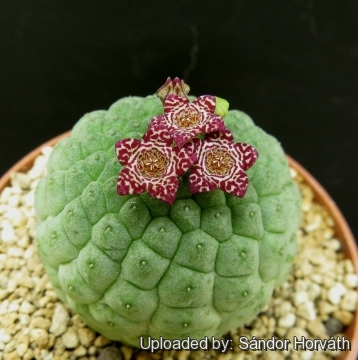 Leachiella marlothii (Larryleachia marlothii) Photo by: Sándor Horváth
Leachiella marlothii (Larryleachia marlothii) Photo by: Sándor Horváth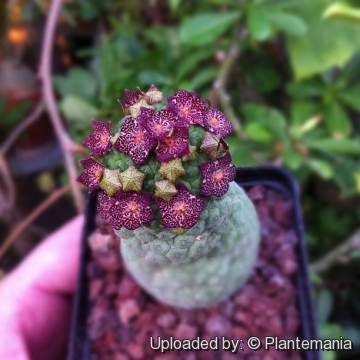 Leachiella marlothii (Larryleachia marlothii) Photo by: © Plantemania
Leachiella marlothii (Larryleachia marlothii) Photo by: © Plantemania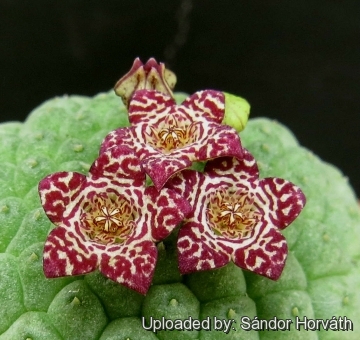 Leachiella marlothii (Larryleachia marlothii) Photo by: Sándor Horváth
Leachiella marlothii (Larryleachia marlothii) Photo by: Sándor Horváth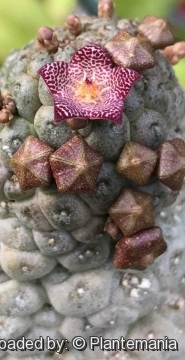 Leachiella marlothii (Larryleachia marlothii) Photo by: © Plantemania
Leachiella marlothii (Larryleachia marlothii) Photo by: © PlantemaniaCultivation and Propagation: Larryleachia marlothiiSN|32234]]SN|32234]] is a slow growing species of relatively easy culture. If grown correctly, it will reward the grower with generous displays of flowers.
Potting medium: Since roots are quite shallow, use a cactus mix or add extra perlite or pumice to regular soil potting soil. A gritty, very free-draining compost is suitable, and clay pots help the plants to dry out between watering.
Fertilization: Feed with a high potassium fertilizer in summer.
Light requirements: High levels of light are needed to flower and for good development. Can be sunburned if moved from shade/greenhouse into full sun too quickly. During the spring it may be able to take full sun until the heat arrives at the end of spring. In an area that has hot afternoon sun, it may be able to take full morning sun, but requires afternoon shade or afternoon light shade.
Watering Needs: water normally in the growing season, but do not overwater (very wet-sensitively, especially in light of its small root system) Water thoroughly only if soil is dry to the touch, let soil dry in between to prevent root rot, keep dry in the winter with ample airflow. Care must be taken with watering as they tends to become swollen and untidy in growth habit if given too much water and shade.
Hardiness: It is quite frost resistant if kept dry, hardy as low as -5° C (or less)
Warning: Larryleachia marlothiiSN|32234]]SN|32234]] – one of the spineless ghaap species - caused poisoning of Coloured children, and proved to contain a rare nerve poison.
Propagation: Seeds or division, wait until the offsets that appear at the base of old clustered specimens are 1/3 the size of the parent and then detach and plant. Larryleachia marlothiiSN|32234]]SN|32234]] can be grown as a graft on Ceropegia tubers.














